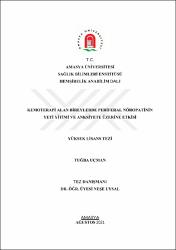Kemoterapi alan bireylerde periferal nöropatinin yeti yitimi ve anksiyete üzerine etkisi

View/
xmlui.dri2xhtml.METS-1.0.item-rights
info:eu-repo/semantics/openAccessDate
2021Metadata
Show full item recordAbstract
Bu çalışmanın amacı, nörotoksik kemoterapi (taxan, platin grubu) alan bireylerde periferal nöropatinin yeti yitimi ve anksiyete ile ilişkisini belirlemektir. Tanımlayıcı, ilişki arayıcı tipte yürütülen çalışmanın evrenini Mart 2021-Temmuz 2021 tarihleri arasında bir hastanenin kemoterapi ünitesinde taksan ve platin bazlı kemoterapi ilaçlarından en az bir tanesini alan bireyler oluşturmuştur. Çalışmanın örneklem sayısının hesaplanmasında power analizi sonuçları kullanılmıştır. Çalışmaya en az 3 kür nörotoksik kemoterapi alan, 18-65 yaş arasında olan ve çalışmaya katılmaya onam veren 180 hasta dahil edilmiştir. Araştırmada veriler, Tanıtıcı Bilgi Formu, Advers Olaylar için Ortak Terminoloji Kriterleri Versiyon 5.0-Periferal Nöropati, Kısa Yeti Yitimi Anketi ve Beck Anksiyete Ölçeği kullanılarak toplanmıştır. Çalışmada nörotoksik kemoterapi alan bireylerde periferal nöropati sıklığı %73,3 olarak saptanmıştır. Nöropati şiddeti grade 0 olan hastaların %30,8'inde, grade 1 nöropatisi olan hastaların %51,9'unda, grade 2 ve 3 nöropatisi olan hastaların %17,3'ünde orta düzeyde yeti yitimi olduğu ve hastaların yeti yitimi puanlarının nöropati şiddetine göre anlamlı farklılık gösterdiği belirlenmiştir (p<0,05). Nöropati şiddeti grade 0 olan hastaların %29,4'ünde, grade 1 nöropatisi olan hastaların %41,2'sinde, grade 2 ve 3 nöropatisi olan hastaların %29,4'ünde orta düzeyde anksiyete olduğu ve hastaların anksiyete puanlarının nöropati şiddetine göre istatistiksel olarak anlamlı farklılık gösterdiği saptanmıştır (p<0,05). Nöropati gelişen bireylerde cinsiyet, metastaz durumu, radyoterapi alma, daha önce kemoterapi tedavisi alma ve tanı süresine göre yeti yitimi düzeylerinin anlamlı farklılık gösterdiği belirlenmiştir. Çalışmamızda nöropati sıklığının yüksek olduğu, nöropati şiddetinin anksiyete ve yeti yitimi düzeyleri ile ilişkili olduğu saptanmıştır. Nöropati semptomlarının hastalar üzerindeki etkilerine yönelik daha fazla çalışma yapılması, nöropatinin akut ve kronik etkileriyle başa çıkmaya yönelik girişimlerin hemşirelik bakımına dahil edilmesi önerilmektedir. The aim of this study is to determine the relationship of peripheral neuropathy on anxiety and disability in individuals receiving neurotoxic chemotherapy (taxan, platinum group). The population of the descriptive, correlational study consisted of individuals who received at least one of the taxane and platinum-based chemotherapy drugs in the chemotherapy unit of a hospital between March 2021 and July 2021. Power analysis results were used to calculate the study sample number. The study sample consisted of 180 patients aged between 18-65 years who received at least 3 courses of neurotoxic chemotherapy and gave consent to participate in the study. Research data were collected using Descriptive Information Form, Common Terminology Criteria for Adverse Events version 5.0-Peripheral Neuropathy, Brief Disability Questionnaire, and Beck Anxiety Inventory. In our study, the prevelance of peripheral neuropathy was found to be 73.3% in individuals receiving neurotoxic chemotherapy. Moderate disability was found in 30.8% of patients with grade 0 neuropathy, 51.9% of patients with grade 1 neuropathy, and 17.3% of patients with grade 2 and 3 neuropathy and the disability scores of the patients differed significantly according to the severity of neuropathy (p<0.05). Moderate anxiety was reported in 29.4% of patients with grade 0 neuropathy, 41.2% of patients with grade 1 neuropathy, and 29.4% of patients with grade 2 and 3 neuropathy and the anxiety scores of the patients showed a statistically significant difference according to the severity of neuropathy (p<0.05). It was determined that disability levels differed significantly in individuals with neuropathy according to gender, metastasis status, radiotherapy, previous chemotherapy treatment, and duration of diagnosis. In our study, it was determined that the prevelance of neuropathy was high and the severity of neuropathy was associated with anxiety and disability levels. It is recommended that more studies be conducted on the effects of neuropathy symptoms on patients, and that interventions to cope with the acute and chronic effects of neuropathy should be included in nursing care.
URI
https://tez.yok.gov.tr/UlusalTezMerkezi/TezGoster?key=v7BkNnnepTnbhn8rNR77LRkpJiy74-F7K0oMIJwvQni7MAISuyKGbqbN8MK0d0K4https://hdl.handle.net/20.500.12450/1994
Collections
- Tez Koleksiyonu [103]

















